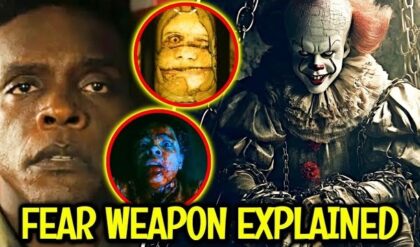Netflix’s latest hit series, Adolescence, has taken the world by storm with its raw portrayal of teenage turmoil, family dynamics, and the haunting ripple effects of a single, life-altering moment. Whether you’ve binged it in one sitting or savored each episode, there’s no denying the show’s ability to pull viewers into its gritty, emotional depths. But even the most eagle-eyed fans might have overlooked some subtle details, hidden easter eggs, and behind-the-scenes brilliance that elevate Adolescence to a whole new level. From symbolic clues to masterful cinematography, here are 13 things you probably missed while watching Adolescence – and trust us, they’ll make you want to hit “rewatch” immediately.
1. The Slash in the Wallpaper: A Silent Confession
Right from the opening scene of Episode 1, as DI Luke Bascombe storms into Jamie Miller’s bedroom, there’s a fleeting moment that screams louder than any dialogue: a jagged slash in the wallpaper. Jamie tries to cover it up as the officers cuff him, but this tiny detail hints at the violent act he’s accused of – the fatal stabbing of Katie Leonard. On a rewatch, it’s chilling to realize this could be where he hid the knife after the crime, a subtle nod to his guilt that slips by unnoticed amidst the chaos.
2. Katie’s Voice in the Soundtrack
Katie, the murdered schoolgirl, barely appears in the series beyond mentions and blurry CCTV footage. But did you catch her presence woven into the score? Director Philip Barantini revealed that the haunting vocals in Episode 2’s soundtrack are performed by the actress who plays Katie. It’s a poignant choice that ensures her spirit lingers throughout the narrative, even if her voice is absent from the dialogue. Next time you hear that eerie melody, know it’s Katie singing from beyond.
3. The One-Shot Magic
Each of Adolescence’s four episodes is filmed in a single, unbroken take – a technical feat that’s easy to miss if you’re caught up in the story. From the seamless glide of the camera in Episode 2, moving from a bustling schoolyard to the somber crime scene, to the claustrophobic tension of Jamie’s interrogation, this method immerses you in real-time drama. It’s not just a gimmick; it mirrors the unrelenting pressure the characters face, with no cuts to offer relief.
4. The Teddy Bear’s Hidden Meaning
In the heart-wrenching finale, Eddie Miller (played by Stephen Graham) collapses in Jamie’s room, clutching a teddy bear and whispering, “I should have done better.” What you might not know is that this line was improvised – it wasn’t in the original script. The bear, a relic of Jamie’s lost innocence, becomes a vessel for Eddie’s regret. It’s a small but powerful detail that underscores the show’s theme of parental failure in the face of teenage rebellion.
5. A Nod to Real-Life Tragedies
Eagle-eyed viewers have speculated that the photographs pinned to the crime scene board in Episode 3 resemble real-life victims and perpetrators of youth violence in the UK. While the creators haven’t confirmed this, writer Stephen Graham has hinted that Adolescence draws inspiration from actual cases of young boys committing violent acts against girls. This subtle reference adds a layer of realism that makes the series even more unsettling.
6. The Color of Innocence
Pay attention to the colors in Jamie’s bedroom – bright blues and yellows dominate, evoking a childlike innocence that clashes with the dark reality of his actions. As the series progresses, these hues fade into grays and shadows during key scenes, symbolizing the erosion of his youth. It’s a visual cue you might miss on a first watch, but it brilliantly mirrors his descent into culpability.
7. Hannah Walters’ Cameo
Did you spot Stephen Graham’s real-life wife, Hannah Walters, in the series? She makes a brief appearance in Episode 3 as a prison staff member, a blink-and-you’ll-miss-it moment that ties into the couple’s off-screen collaboration. As co-founder of Matriarch Productions, Walters played a key role in bringing Adolescence to life, and her cameo is a sweet nod to their partnership.
8. The Psychologist’s Subtle Defeat
Briony Ariston, the psychologist assessing Jamie, is a strong female presence in a male-dominated story. But watch closely in Episode 3 when she asks a prison guard for access to the observation room. His condescending lecture about “body language” – something she’s clearly an expert in – is a quiet jab at the casual sexism she faces. It’s a fleeting exchange, but it underscores the show’s critique of toxic masculinity.
9. Jamie’s Shoes: A Clue to His Mindset
In the arrest scene, Jamie’s sneakers are scuffed and worn, a detail that might seem insignificant. Yet, paired with his otherwise neat appearance, they suggest a boy teetering between order and chaos – a perfect metaphor for his fractured psyche. Compare this to the pristine shoes of his peers in the schoolyard flashback, and you’ll see how this subtle prop choice sets him apart.
10. The Clock That Never Moves
During Jamie’s interrogation, a wall clock looms in the background, but its hands never budge. This isn’t a production error – it’s a deliberate choice to trap viewers in a timeless limbo, reflecting Jamie’s stalled emotional growth and the endless scrutiny he faces. It’s a detail so easy to overlook, yet it amplifies the scene’s tension tenfold.
11. Eddie’s Broken Promise
In Episode 1, Eddie casually promises Jamie they’ll “sort everything out” over breakfast – a line that feels throwaway until the finale reveals his inability to keep that vow. This broken promise haunts their relationship, and on a rewatch, you’ll catch how Eddie’s optimism crumbles as the series unfolds. It’s a heartbreaking thread woven into the dialogue.
12. The Mirror Moment
Midway through Episode 2, Jamie stares into a bathroom mirror, his reflection distorted by cracked glass. It’s a quick shot, but the fractured image symbolizes his shattered sense of self – a boy caught between innocence and guilt. The mirror’s damage isn’t random; it’s a visual echo of the chaos he’s unleashed, missed by many on a first viewing.
13. The Final Shot’s Double Meaning
The series ends with Eddie weeping in Jamie’s room, the camera pulling back to reveal an empty house. But look closer: the faint sound of a siren in the distance ties this moment to the opening raid, creating a cyclical narrative. It suggests that the cycle of violence and regret continues beyond the screen – a chilling detail that lingers long after the credits roll.
Why These Details Matter
Adolescence isn’t just a crime drama; it’s a tapestry of subtle storytelling that rewards the observant. These 13 hidden gems – from symbolic props to cinematic sleight-of-hand – deepen the show’s exploration of youth, guilt, and societal failure. They’re easy to miss amid the emotional weight of the plot, but they’re what make Adolescence a standout in Netflix’s lineup.
Stephen Graham, who co-wrote and stars in the series, told Digital Spy that the goal was to “flip the script” on traditional procedurals, focusing on the “why” rather than the “who.” These details are the backbone of that mission, inviting viewers to piece together the puzzle themselves. And with a global audience still buzzing about the show over a week after its March 2025 release, it’s clear this approach has paid off.
So, next time you fire up Adolescence, keep your eyes peeled. These secrets aren’t just Easter eggs – they’re the keys to unlocking the full brilliance of a series that dares to confront the darkest corners of growing up. What did you miss? Maybe it’s time for that second watch.





